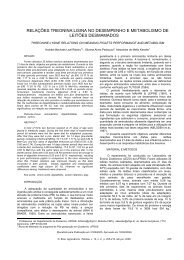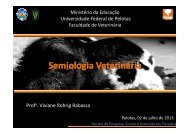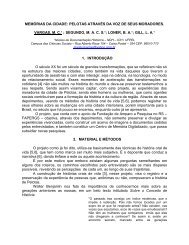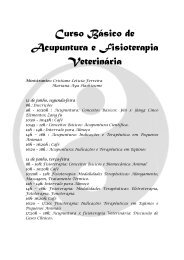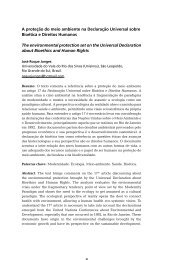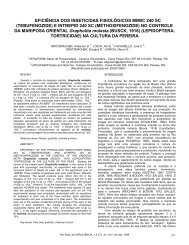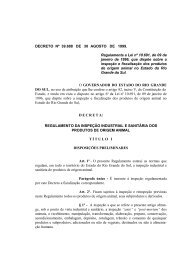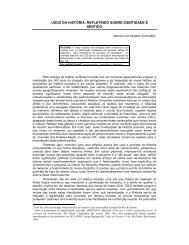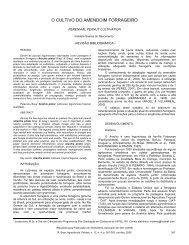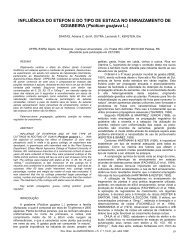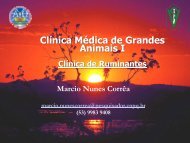IDENTIFICATION OF RICE MUTANTS (Oryza sativa L.) FOR ...
IDENTIFICATION OF RICE MUTANTS (Oryza sativa L.) FOR ...
IDENTIFICATION OF RICE MUTANTS (Oryza sativa L.) FOR ...
You also want an ePaper? Increase the reach of your titles
YUMPU automatically turns print PDFs into web optimized ePapers that Google loves.
<strong>IDENTIFICATION</strong> <strong>OF</strong> <strong>RICE</strong> <strong>MUTANTS</strong> (<strong>Oryza</strong> <strong>sativa</strong> L.) <strong>FOR</strong> AGRONOMICAL ANDROOT SYSTEM TRAITSIDENTIFICAÇÃO DE MUTANTES DE ARROZ (<strong>Oryza</strong> <strong>sativa</strong> L.) PARA CARACTERÍSTICAS AGRONÔMICAS E DOSISTEMA DE RAÍZESZIMMER, Paulo D. 1 ; MATTOS, Luiz A. T. de 2 ; OLIVEIRA, Antonio C. de 3 ; CARVALHO, Fernando I. F. de 3 ; MAGALHÃES JR.,Ariano 4 ; KOPP, Maurício M. 2 ; FREITAS, Fabio A. de 2ABSTRACTMutation techniques are very important tools to study geneticvariability, function, action and regulation of genes. Moreover, in plantbreeding the root system is traditionally selected in an indirect way. Inthis paper we propose the use of mutation techniques to directly selectmutants affecting root morphophysiological traits for future mappingand cloning of the genes involved. After preliminary tests to identify thebest radiation dose, 2,500 and 3,500 seeds from cultivar Taim, indicasub species, were irradiated with doses 200 Gy and 250 Gy,respectively, and grown in a protected area. After harvesting, M 2 seedswere dried, stored and plantlets were evaluated in hydroponic culture,aiming to identify potential root mutants. The dose of 200 Gy seems tobe associated with increases in number of seminal roots. From 9,737seeds evaluated we selected 623 putatively root mutants. Moreover,we selected plants with high and low number of seminal roots. Whichcan be important to evaluate the root effect on plant establishment.The root mutants described will be available to the scientific communitythrough the rice mutation club / FAO / IAEA after their properconfirmation and characterization.Key words: seminal roots, irrigated rice, irradiation, 60 Co, geneticvariability.INTRODUTIONMany studies discuss the needs and difficulties toincrease world grain production (BORLAUG, 1983; ZAPATA &IZQUIERDO, 1994; BORLAUG, 1997; MANN, 1997 and 1999).Many recent tools have been described as very important notonly for the goal of increasing production, but also forimproving quality traits, i.e., the application of molecularmarkers looking for genetic potential from the wild (TANKSLEY& MCCOUCH, 1997), implementation of QTL – QuantitativeTrait Loci – transfer methods by MAS – Marker Assistedselection – (FRARY et al., 2000) and the possibility to increaseprovitamin A in rice endosperm by GMO – Genetically ModifiedOrganism - production (YE et al., 2000).To increase yield potential, it is necessary the assemblyof many techniques that form modern genetic breedingprograms such as empiric selection, MAS and genomicmethods (STUBER et al., 1999). Also changes in the paradigmof phenotypic selection to gene selection and disregardingdifferences between classical and modern breeding, as well asbetween transgenic and non-transgenic plants have beensuggested (KOORNNEEF & STAM, 2001).Induced mutation is an important tool in rice breedingworldwide (MALUSZYNSKI, 1998; MALUSZYNSKI et al.,1998). In Brazil, breeding programs have used this technologyin wheat as an efficient method to correct a deficiency in acultivar (TULMANN NETO et al., 1995 a) and in soybean toincrease the earliness (TULMANN NETO et al., 1995 b).PANDINI et al. (1997) obtained very close results whencomparing two strategies, induced mutation and reciprocalcrosses aiming to obtain genetic variability in triticale for plantheight. Worldwide, many studies have contributed to increasethe world grain production and to produce mutants for manytraits (MALUSZYNSKI et al., 1998). Although, except to maize,barley and tomato, mutants generated and not included intobreeding programs were lost. Nowadays, mutants for all traitsare very important for variability studies, function, regulationand action of genes, mainly because of the new technologiesavailable. To facilitate genetic variability studies, it is necessaryto decrease the phenotypic gap; therefore, genomes might bestudied in greater depth – by knowing new mutants in thesame loci – and greater breath – by knowing new mutated loci(MALUSZYNSKI, 1998).Genomics has contributed to comparative studiesespecially after the recent development of molecular markertechnology and bioinformatics (LIU, 1998). Moreover, theutilization of small genomes as models, such rice, contributesto genomic studies, mainly because of the synteny amongcereals (BENNETZEN & FREELING, 1993; GALE & DEVOS,1998; MALUSZYNSKI, 1998; WILSON et al., 1999;McCOUCH, 2001).In this context, our goal was to obtain mutants for the riceroot system and other agronomical traits by irradiation seedswith 60 Co.MATERIAL AND METHODSRice seeds from cultivar Taim, indica sub specie, wereirradiated with 60 Co in an Eldorado 78 apparatus (Centroregional de oncologia/UFPel). Seeds were placed 10centimeters distant from the radiation source, at this distanceradiation is 24.25 Gy per minute. Therefore, for the dose of 200Gy, seeds were exposed for 8 minutes and 15 seconds, andfor 250 Gy, seeds were exposed for 10 minutes and 191 BSc., MSc., Graduate student PPGCTS / FAEM / UFPel. C.P. 354, CEP. 96010-900 Pelotas - RS, e-mail: dejalma@msn.com;2 BSc., Graduate student PPGA / FAEM / UFPel, C.P. 354, CEP. 96010-900 Pelotas - RS3 BSc., PhD, Associate Professor of Genetics and Plant Breeding FAEM / UFPel, C.P. 354, CEP. 96010-900 Pelotas - RS4 BSc., MSc., Researcher of Embrapa Clima Temperado, C.P. 403, CEP. 96001-970 Pelotas – RS(Recebido para publicação em 15/08/2002)R. bras..Agrociência, v. 9, n. 3, p. 195-199, jul-set, 2003 195
ZIMMER et al. Identification of rice mutants (<strong>Oryza</strong> <strong>sativa</strong> L.) for agronomical and root system traitsseconds. For one hour before and after irradiation, seeds weresubjected to distilled water.To establish the radiation doses used in this work wecarried out a preliminary experiment with different doses: 0, 25,50, 100, 200 and 400 Gy. Each dose was composed of 200seeds, the evaluation of the best dose was performedcomparing the number of plants 20 days after germination.Two doses were used to obtain M 1 plants: 2,500 seedswere irradiated with 200 Gy (first area) and 3,500 seeds wereirradiated with 250 Gy (second area). After radiation, M 1 seedswere sowed and grown in greenhouse for one month and thenplanted in the field. M 1 plants were grown in field conditionsuntil seed maturity.After harvesting of M 2 seeds screening of the mutantsstarted. A total of 9,737 M 2 seeds were evaluated. Initially,seeds were treated per 10 minutes with 0.2% sodiumhypochlorite, avoiding fungi contamination. After this treatmentseeds were washed immediately with sterile distilled water andput directly over pots having nylon net in contact with thehydroponic solution, to germinate. Hydroponic solution wasperformed as described by CAMARGO & OLIVEIRA (1981).Fifteen days later, the root system was evaluated. Traitsevaluated were: number of seminal roots, earlier main rootdegeneration, main root absent or degenerated, albinism,disoriented growth, total collapse, dwarfing and others. Allputative mutants and wild types were transferred to field toscore for other traits. On field, plants were also evaluated for:cycle, plant height, dwarfness, plant and leaf architecture,absence of tiller and others with abnormal behavior. Putativemutants were identified and separately harvested.Because of the great segregation of seminal root numbertrait, a comparative study was performed among control, 200Gy M 2 seeds and 250 Gy M 2 seeds. One thousand seeds foreach treatment were evaluated. Seeds were germinated inorientated growing as described in RAS (1992). Root systemwas evaluated according to seminal root number in eightclasses. Starting from the frequencies of each class apolynomial regression was built for each treatment with theMicrosoft Excel software.RESULTS AND DISCUSSIONPreliminary results did not show germination differencesbetween zero to 200 Gy (approximately 80% - data notshown). However, 400 Gy affected drastically the germination.Besides these results, MALUZYNSKI * suggested the use of200 and 250 Gy to irradiation seeds looking for root mutants. Itpointed out to the range of radiation doses to choose forobtaining M 1 plant populations, 200 Gy (first area) and 250 Gy(second area). Furthermore, Shwewartun, a rice varietyreleased in Myanmar in 1975 by U Tim Myint and U Khin Win,was obtained by irradiation of the variety IRS with 250 Gy(MALUSZYSNKI et al., 1998), which is consistent with thedoses used in the present study. In the first area (200 Gy)1,221 M 1 plants were harvested from 2,500 irradiated seeds,representing about 49% of productive or fertile plants. In thesecond area (250 Gy) 1,410 M 1 plants were harvested from3,500 irradiated seeds, representing almost 40% of productiveor fertile plants. These results characterize the negative effectsof the higher radiation doses in plant survival, although plantsirradiated with 200 Gy and 250 Gy produced similar number ofseeds (data not shown).* FAO/International Atomic Energy Agency – Vienna, Austria.Root system analyses were performed in hydroponicculture. From 9,737 seeds evaluated, 8,751 plantlets wereobtained (~90%) and were planted in the field. A total of 623(7.11%) possible mutants were identified (Table 1). From thistotal, 120 (1.37%) had no seminal roots, 192 (2.19%) wereeither rootless or earlier root degeneration, 5 (0.06%) plantletsshowed a collapsed root system and 14 (0.16%) haddisoriented growing (Table 1). These results are in agreementwith SZAREJKO & MALUSZYNSKI (1980), who obtained 3.3%of root mutants by seed treatment with a combination of NaN 3and Nmit (N-methyl-N-nitrosourea). Some putative mutantsmay be observed in Figure 1.Table 1 – Putatively mutants identified from 8,751 M 2 riceplantlets evaluated in a hydroponic system.DescriptionNumber % evaluatedWhole plantlets 8751 100Whole putatively mutants 623 7.11Absence or degenerated of main root 192 2.19Absence of seminal root 120 1.37Cycle 97 1.11Plant height 29 0.33Plants tillerless 13 0.15Albinism 30 0.34Dwarfness 62 0.71Root system collapsed 5 0.06Shoot collapsed 2 0.02Plant collapsed 16 0.18Disoriented growing 14 0.16Other traits 43 0.49Many root system mutants were identified andcharacterized in Arabidopsis: alf1, alf2, alf4 (CELENZA et al.,1995), rml1 and rml2 (CHENG et al., 1995), rty (KING et al.,1995) sur1 (BOERJAN et al., 1995); and maize: rt1 (JENKINS,1930; OLIVEIRA & BENNETZEN, 1998) des21 (GAVAZZI etal., 1993), rth1-3 (WEN & SCHNABLE, 1994), irt1(HOCHHOLDINGER & FEIX, 1998 a; HOCHHOLDINGER etal., 2001) rtcs (HERTZ et al., 1996; HOCHHOLDINGER &FEIX, 1998 b). But in rice, projects looking for identifying andorganizing mutant germplasm banks are just beginning. It isvery important to search new mutated loci for contributions tonarrowing the phenotypic gap in rice and other crop species.Essentially, rice is a genetic model for all cereals and the mainfeature that made it as model specie is the synteny amonggrass species (GALE & DEVOS, 1998; BENNETZEN, 2002),the relatively small genome (ARUMUGANATHAN & EARLE,1991) and the economic and social importance. Identificationand characterization of new rice mutants aiming at constructinga germplasm bank are necessary efforts to improve breedingprograms and genetic basic studies.Besides plantlets with anomalies in the root system,many other traits were identified, such as albinism, dwarfnessand collapse of the shoot (Table 1). Furthermore, fieldobservations also allow selecting plants with other altered traitssuch as: 97 plants for cycle, 29 plants for plant height and 13plants tillerless. To select soybean plants for cycle, TULMANNNETO et al. (1995 b) also applied induced mutation in theirstudies.A study carried out to verify the radiation effects on thenumber of seminal roots, presented attractive results. The 200Gy dose increased the number of seminal roots in comparisonto the control and 250 Gy. (Figure 2), indicating a potentialincrease in the frequency of alleles favor a high number ofseminal roots. This tendency was also observed in mutated oat196 R. bras..Agrociência, v. 9, n. 3, p. 195-199, jul-set, 2003
ZIMMER et al. Identification of rice mutants (<strong>Oryza</strong> <strong>sativa</strong> L.) for agronomical and root system traits(400 Gy), although for this species the standard number ofseminal roots was three (FONSECA et al., 2002). The greatvariation in number of seminal roots in rice, including all dosesand the control, suggests that this trait still segregating,according to MALUSZYNSKI (1998), who described that theroot system has not been directly selected. We suggest thatthe selection of plants with high and low number of seminalroots could be important to evaluate the effect of this kind ofroot on plant establishment in future studies.Figure 1 – Some putative mutants selected in hydroponic culture. 1 – Absence of seminal roots, 2, 4 and 6 – control, 3 – root systemcollapsed, 5 – albinism, 7 and 8 – two seminal roots, 9 – early main root degenerated, 10 – plantlet with two apicalmeristems.30Control y = – 1,5476x 2 + 14,414x – 13,8 R 2 = 0,7998Frequency (% of plantlets per class)252015105200 Gy y = – 1,0262x 2 + 12,079x – 16,136 R 2 = 0,7417250 Gy y = – 1,8452x 2 + 16,774x – 16,579 R 2 = 0,856701 2 3 4 5 6 7 8Class (number of seminal root per plantlet)Figure 2 – Seminal root system affected by different radiation doses – data from 1,000 plantlets evaluated in each dose.R. bras..Agrociência, v. 9, n. 3, p. 195-199, jul-set, 2003 197
ZIMMER et al. Identification of rice mutants (<strong>Oryza</strong> <strong>sativa</strong> L.) for agronomical and root system traitsCONCLUSIONSInduced mutation with60 Co is efficient to promotedifferent root system anomalies and to alter other plantagronomic traits.RESUMOAs técnicas de mutações são ferramentas fundamentais paraestudos de variabilidade genética, função, ação e regulação de genes.Além disso, no melhoramento genético de plantas, o sistema de raízesé tradicionalmente selecionado de forma indireta. Neste trabalho,propõe-se a utilização de técnicas de indução de mutações paraselecionar diretamente mutantes que afetam característicasmorfológicas do sistema de raízes do arroz, para futuramente mapeare clonar os genes envolvidos. Após estudos preliminares paraidentificar a melhor dose de irradiação, foram irradiadas 2.500sementes com 200 Gy e 3.500 sementes com 250 Gy. Após airradiação as sementes foram semeadas em área protegida paraobtenção da geração M 2. Após a colheita, as sementes M 2 foramsecas e estocadas. Os mutantes para o sistema de raízes foramidentificados em cultivo hidropônico e as características ciclo eestatura foram avaliadas no campo. A dose de 200 Gy parece estarassociada com o incremento do número de raízes seminais, indicandoum aumento na freqüência de alelos favoráveis a esta característica.De um total de 9.737 sementes M 2 avaliadas, selecionou-se 623possíveis mutantes. Além disso, foram selecionadas plantas com altoe baixo número de raízes seminais, sendo que estes mutantespoderão ser importantes para estudos relacionados ao efeito dasraízes no estabelecimento das plantas no campo. Os mutantesidentificados serão disponibilizados para a comunidade científicamundial através do Clube de Mutantes de Arroz / FAO / IAEA, após asdevidas confirmações e caracterizações.Palavras - chave: raiz seminal, arroz irrigado, 60 Co, variabilidadegenética.ACKNOWLEDGMENTSWe thank the support received from FAO/IAEA(International Atomic Energy Agency), Fundação de Ampario aPesquisa do Rio Grande do Sul (FAPERGS), ConselhoNacional de Desenvolvimento Científico e Tecnológico(CNPq), Coordenação de Aperfeiçoamento de Pessoal deNível Superior (CAPES) (fellowship to P.D. Z.) andUniversidade Federal de Pelotas (UFPel).REFERENCESARUMUGANATAN, K.; EARLE E.D. Nuclear DNA content ofsome important plant species. Plant Molecular BiologyReport, v. 9, p. 208-218, 1991.BENNETZEN, J.L. Opening the door to comparative plantbiology. Science, v. 296, p.60-63, 2002.BENNETZEN, J.; FREELING, M. Grasses as a single geneticsystem – genome composition, colinearity and compatibility.Trends in Genetics, v. 9, p. 259-261, 1993.BOERJAN, W.; CEVERA, M.T.; DERLARVE, M. et al.Superroot, a recessive mutation in Arabidopsis, confer auxinoverproduction. The Plant Cell, v. 7, p. 1405-1419, 1995.BORLAUG, N.E. Contribution of conventional plant breeding tofood production. Science, v. 219, p. 689-693, 1983.BORLAUG, N.E. Feeding a world of 10 billion people: themiracle ahead. Plant Tissue Culture and Biotechnology, v.3, n. 3, p. 119-127, 1997.BRASIL. Ministério da Agricultura, Pecuária e AbastecimentoRegras para Análise de Sementes, Brasília, 1992. 365 p.CAMARGO, C. E.; OLIVEIRA, O. F. Tolerância de cultivaresde trigo a diferentes níveis de alumínio em solução nutritiva eno solo. Bragantia, Campinas, v. 40, n. 3, p. 21-31, 1981.CELENZA Jr, J.L.; GRISAFI, P.L.; FINK, F.R. A pathway forlateral root formation in Arabidopsis thaliana. Genes &Development, v. 9, p. 2131-2142, 1995.CHENG, J.C.; SEELEY, K.A.; SUNG, Z.A. RML1 e RML2,Arabidopsis genes required for cell proliferation at the root tip.Plant Physiology, v. 107, p. 365-376, 1995.FONSECA, F.S. da; ZIMMER, P.D.; MATTOS, L.A.T. de, et al.Avaliação morfológica em plântulas, M 2 de aveia (Aveia <strong>sativa</strong>L.) irradiadas com raios gama ( 60 Co). In: REUNIÃO DACOMISSÃO BRASILEIRA DA PESQUISA DE AVEIA, 22.,2002, Passo Fundo, RS, Anais... Passo Fundo, 2002, p. 356-358.FRARY, A.; NESBITT, T.C.; FRARY, A. et al. fw2.2: Aquantitative trait locus key to the evolution of tomato fruit size.Science, v. 289, p. 85- 88, 2000.GALE, M.D.; DEVOS, K.M. Plant comparative genetics after 10years. Science, v. 282, p. 656-659, 1998.GAVAZZI, G.; DOLFINI, M.; GALBIATI, M. et al. Mutantaffecting germination and early seedling development in maize.Maydica, v. 38, p. 265-274, 1993.GO<strong>OF</strong>, S.A.; RICHE, D.; LAN, RH. et al. A draft sequence ofthe rice genome (<strong>Oryza</strong> <strong>sativa</strong> L. ssp. Japonica), Science, v.296, p. 92-100, 2002.HERTZ, W.; HOCHHOLDINGER, F.; SCHWALL, M. et al.Isolation and characterization of rtcs, a mutant deficient in theformation of nodal roots. Plant Journal, v. 10, p. 845-857,1996.HOCHHOLDINGER, F.; FEIX, G. Early post-embryonic rootformation is specifically affected in the maize mutant lrt1. PlantJournal, v. 16, p. 247-255, 1998 a.HOCHHOLDINGER, F.; FEIX, G. Cyclin expression iscompletely suppressed at the site of crown root formation inthe nodal region of the maize root mutant rtcs. Journal ofPlant Physiology, v. 153, p. 425-429, 1998 b.HOCHHOLDINGER, F.; PARK, W.J.; FEIX G. Cooperativeaction of SLR1 and SRL2 is required for lateral root specificcell-elongation in maize. Plant Physiology, special edition:grasses, v. 125, p. 1529-1539, 2001.JENKINS, M.T. Hereditable characters of Maize XXXIVrootless.Journal of Heredity, v. 21, p. 79-80, 1930.KING, J.J.; STIMART, D.P.; FISHER, R.H. et al. A mutationaltering auxin homeostasis and plant morphology inArabidopsis. The Plant Cell, v. 7, p. 2023-2037, 1995.KOORNNEEF, M.; STAM, P. Changing paradigms in plantbreeding. Plant Physiology, v. 125, p. 156-159, 2001.MALUSZYNSKI, M. Crop germplasm enhancement throughmutation techniques. In: INTERNATIONAL SYMPOSIUM ON<strong>RICE</strong> GERMPLASM EVALUATION AND ENHANCEMENT ,1999, Arkansas, USA. Abstracts… J.N. Rutger, J.F.Robinson, and R.H. Dilday, editors. Arkansas, USA. August 30– September 2, 1998.MALUSZYNSKI, M.; AHLOOWALIA, A.; ASHRI, A. et al.Induced mutations in rice breeding and germplasmenhancement. In: SESSION <strong>OF</strong> THE INTERNATIONAL <strong>RICE</strong>COMMISSION, 19., 1998, Cairo, Proceedings…. Cairo,Egypt, 7-9 September 1998.MANN, C.C. Reseeding the green revolution. Science, v. 277,n. 5329, p. 1038-1043, 1997.MANN, C.C. Crop scientists seek a new revolution. Science, v.283, n. 5400, p. 310-314, 1999.198 R. bras..Agrociência, v. 9, n. 3, p. 195-199, jul-set, 2003
ZIMMER et al. Identification of rice mutants (<strong>Oryza</strong> <strong>sativa</strong> L.) for agronomical and root system traitsMcCOUCH, S.R. Genomics and synteny. Plant Physiology, v.125, p. 152-155, 2001.OLIVEIRA, A.C.; BENNETZEN, J.L. Molecular mapping of thert1 gene in maize In: ANNUAL MAIZE GENETICSCONFERENCE, 40., 1998, Lake Geneva, Abstracts…. LakeGeneva: maize genetics, 1998, p. 32.PANDINI, F.; CARVALHO, F.I.F.; BARBOSA NETO, J.F. Plantheight reduction in populations of triticale (X triticosecaleWittmack) by induced mutations and artificial crosses.Brazilian Journal of Genetics, v. 20, n. 3, p. 483-488, 1997.STUBER, C.W.; POLACCO, M.; SENIOR, M.L. Synergy ofempirical breeding, marker-assisted selection and genomics, toincrease crop yield potential. Crop Science, v. 39, p. 1571-1583, 1999.SZAREJKO, I.; MALUSZYNSKI, M. Analysis of usefulness ofsodium azide in plant breeding. Acta Biologica, v. 9, p. 60-66,1980.TANKSLEY, S.D.; MCCOUCH, S.R. Seed banks andmolecular maps: unlocking genetic potential from the wild.Science, v. 277, p. 1063-1066, 1997.TULMANN NETO, A.; CAMARGO, C.E. DE O.; ALVES, M.C.et al. Indução de mutação visando obtenção de resistência adoenças na cultivar de trigo IAC-24. Pesquisa AgropecuáriaBrasileira, Brasília, v. 30, n. 4, p. 497-504, 1995 a.TULMANN NETO, A.; PEIXOTO, T.; ALVES, M.C. et al.Indução de mutação na cultivar de soja IAC-8 visando àobtenção de precocidade. Pesquisa AgropecuáriaBrasileira, Brasília, v. 30, n. 2, p. 237-244, 1995 b.WEN, T.J.; SCHNABLE, P.S. Analyses of mutants of threegenes that influence root hair development in Zea mays(Gramineae) suggest that root hairs are dispensable.American Journal of Botany, v. 81, p. 833-843, 1994.WILSON, W.A.; HARRINGTON, S.E.; WOODMAN, W.L. et al.Inferences on the genome structure of progenitor maizethrough comparative analysis of rice, maize and thedomesticated panicoids. Genetics, v. 153, p. 453-473, 1999.YE, X.; AL-BABILI, S.; KLÖTI, A. et al. Engineering theprovitamin A (β-carotene) biosynthetic pathway into(Carotenoid-free) rice endosperm. Science, v. 287, p. 303-305, 2000.YU, J.; HU, S.; WANG, J. et al. A draft sequence of the ricegenome (<strong>Oryza</strong> <strong>sativa</strong> L. ssp. Indica). Science, v. 296, p. 79-92, 2002.ZAPATA, F.J.; IZQUIERDO, J. La producción de arroz enAmérica Latina y el Caribe: logros, posibilidades y desafíos. In:REUNIÓN DE LA COMISIÓN INTERNACIONAL DEL ARROZ– FAO, 18., 1994, Roma, Italia, Abstracts... Roma: FAO,Septiembre, 1994, p. 5-9.R. bras..Agrociência, v. 9, n. 3, p. 195-199, jul-set, 2003 199



